|
- Catalog (in stock)
- Back-Catalog
- Mail Order
- Online Order
- Sounds
- Instruments
- Projects
- History Face
- ten years 87-97
- Review Face
- our friends
- Albis Face
- Albis - Photos
- Albis Work
- Links
- Home
- Contact
- Profil YouTube
- Overton Network
P & C December 1998
- Face Music / Albi
- last update 03-2016
|
|
more information Quartet Georgika - in German
|
- Mamuka Tchitchinadze: Gesang (Solist)
- Aleko Khizanishvili: Gesang, Salamuri, Tschonguri
- Khvicha Khvtisiashvili: Gesang, Panduri
- Dato Bukhasianidze: Gesang, Bass Panduri
Die Musiker sind Mitglieder des Ensemble Georgika. Die beiden Instrumentalisten Aleko und Khvicha kennen sich bereits aus der Jugendzeit. Sie haben später in der Instrumentalgruppe beim Palast für Folklore mitgespielt. Mit dem Gitarristen Dato Bukhasianidze wurden sie im Militärdienst bekannt. Mamuka Tchitchinadze ist seit dessen Gründung in den 90er Jahren einer der wichtigen Solisten des Ensemble Georgika.
Neben ihrer grossartigen vokalen Mehrstimmigkeit kennt die georgische Musiktradition auch Instrumente: Blasinstrumente: Die Flöte Salamuri, sowohl mit (eniani) wie ohne Schnabel (ueno) bekannt, ist wie auch die heute vergessene Panflöte Soinari / Lertchemi ein reines Soloinstrument, dessen sich vor allem Hirten bedienten. Der Dudelsack Gudastviri / Tchiboni vor allem, wird aber gelegentlich auch vom Spieler als Begleitinstrument für Sologesang benützt. Die Kniegeige Tchuniri und die Harfe Changi, heute nur noch in der Hochgebirgsregion Svaneti gespielt, werden auch zur Begleitung mehrstimmigen Gesangs eingesetzt. In den tiefer gelegenen Gebieten Georgiens sind vor allem Zupfinstrumente heimisch: im Osten die Panduri, im Westen die Chonguri, auf denen Solo- wie mehrstimmige Gesänge begleitet und auch solistisch Tanzweisen gespielt werden.
Aus den östlichen und südlichen Nachbarländern stammen Rohrblattinstrumente Duduk und Zurna (siehe: Traditional music and instruments of Armenia), die obwohl zeitweise sehr populär, nie über den Bereich der auf ihnen gespielten, stark orientalisch geprägten Festmusik heraus gedrungen sind. Ähnlich verhält es sich mit den Ende des 19. Jahrhundert aufgekommenen Gitarre, die gleich ein neues Genre, einen neuen Musikstil mitgebracht hat. Einzig das Akkordeon wurde in der ostgeorgischen Bergregion Tuscheti voll in die bestehenden Traditionen integriert und dürfte dabei auch ältere Instrumente verdrängt haben.
Aus diesem vielfältigen Bereich, zu dem auch einige Schlaginstrumente zählen, stellt das Quartett Geogika jene drei Instrumente vor, die Eingang ins Konzertleben gefunden haben;
|
- Panduri
Eine dreisaitige Laute, mit drei bis sieben Bünden ist in ganz Ostgeorgien (Kartli und Kakheti) verbreitet. Die Berggebiete (Phsav-Khevsureti, Tusheti) kennen besondere Varianten.
Klangkörper und Hals werden aus einem einzigen Stück Holz gefertigt; nur die Schalldecke aus Tannenholz wird aufgesetzt. Durch die Bünde wird die Oktav in 7 Stufen mit mehr oder weniger gleichem Abstand geteilt. Das führt zu engen Sekundschritten, weiten Mollterzen und Quarten und tiefen Quinten, die für das an die temperierte Stimmung gewöhnte Ohr falsch klingen, aber für die traditionelle Harmonik georgischer Musik charakteristisch sind. [the characteristic flat-fifth tuning is the result of the trets that divide the octave into seven roughly equal steps, producing a low major second, a high minor third and a high fourth, all of which are consistent with quartive scales, but also a low fifth, which is unique].
Es gibt verschiedene Stimmungen, Häufig werden die zweite Saite um eine kleine Terz, die dritte um eine Quart höher gestimmt. Heute werden auch Panduri mit temperierter chromatischer Stimmung hergestellt. Dazu gehört die sog. Bass Panduri, die zur Erweiterung des für die georgische Musik charakteristischen engen Tonraums für neuere Stücken geschaffen wurde. |
|

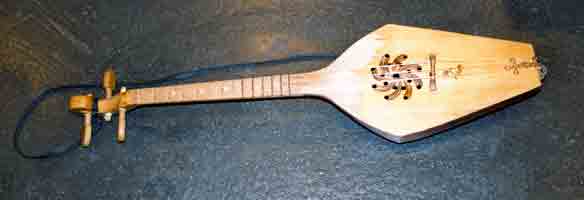
|
|
- Tschonguri / Chonguri
Heisst die Laute der westgeorgischen Talregionen Samegrelo, Imereti, Guria, Atch'ara. Ihr Klangkörper ist aus mehreren Spänen zusammengesetzt. Bünde gibt es auf ihrem langen Griffbrett nicht. Sie besitzt vier Saiten, von denen die am höchsten gestimmte, an dritter Stelle verlaufende ("zily" genannt) kürzer ist. [the higest and unfingered half-length drone string]. Ihr Wirbel befindet sich in der Mitte des Halses, so dass ihre Tonhöhe nicht verändert werden kann. Beim Spiel auf der Tschonguri werden seltener alle 4 Saiten angeschlagen, ihr Klang ist weniger geräuschhaft und trägt länger als der der Panduri. So kommt die hohe Bordunsaite nicht immer zum Einsatz. Es gibt verschiedene Stimmungen; häufig ist der Dur-dreiklang mit oktavverdoppeltem Grundton. |
|
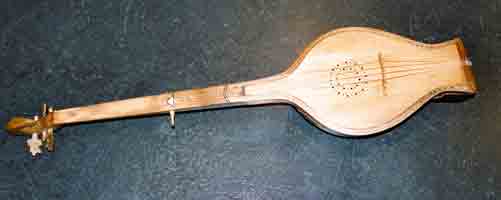
|
|
- Salamuri
Sie wird heute als Schnabelflöte mit acht Grifflächern und Daumenloch gespielt, was ihr die volle chromatische Tonleiter zugänglich macht. Ursprünglichere Formen mit sechs Löchern, oder ihre sehr geräuschhaft klingende schnabellose Gestalt haben den Weg auf das Konzertpodium bisher nicht gefunden. Das Rohr wird aus Aprikosen- oder Walnussholz gefertigt, in das am verengten Ende ein Block eingesetzt wird. |
|

|
Im Gegensatz zur autochthonen Tradition, die nur das solistische Spiel auf der Salamuri kennt, wird sie heute gerne von Panduri und Basspanduri begleitet. Die so entstehende Musik entfernt sich beträchtlich von den Eigenschaften der älteren georgischen Musik (enger Tonraum, der kaum 2 Oktaven erreicht, nicht temperierte Stimmung, durchgehende Diatonik), bietet dem Solisten gute Gelegenheit, seine Virtuosität zu zeigen.
Thomas Häusermann
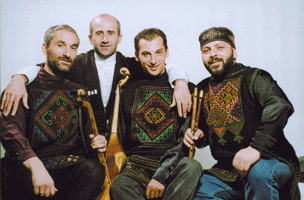 
Dato Bukhasanidze, Mamuka Tchitchinadze, Khvicha Khvtisinashvili, Aleko Khizanishvili - Mamuka Tchitchinadze
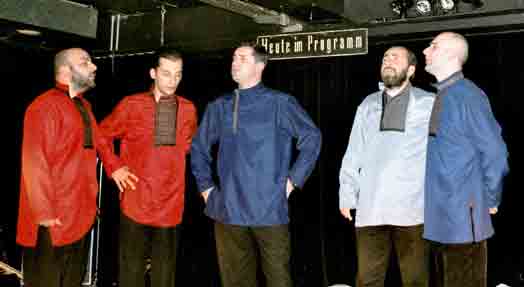
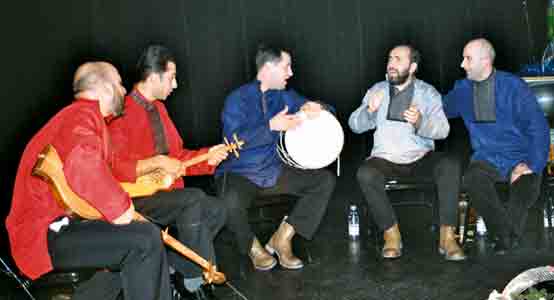
- Traditional Music of Georgia
The Caucasian nation of Georgia has a highly developed tradition of part-singing which has been handed down orally. The polyphony is not the result of an arrangement for the concert performance, it forms part of the essence of this music in which the harmony is often more important than catchy melodic formulae. There is an almost inexhaustible variety of Georgian vocal music. Each region of this widely varied country between the high mountainous region of Caucasia and the Black Sea has its own style, which realizes the possibilities of polyphony in its own way.
For the past hundred years traditional Georgian songs could also be heard in concert: the first performing group was established in 1885 and by 1907, recordings were already being made. Ensemble Georgika, founded in 1989 is, among the many such groups presently performing in Georgia, one of the youngest, and after 70 years of Soviet rule, one of the first to survive without state support and patronage. Its 14 singers and 3 instrumentalists wish not only to continue the existing concert tradition, but based on archive recordings and instruction from authoritative village elders, also strive to preserve its diversity and vivacity.
- latest CD: "FM 50039 - Vol. I" - will follow
Traditional Georgian music was not originally intended for presentation in a concert hall. These centuries-old, orally handed-down songs evolved out of life's important moments within society. It is still kept alive by the inhabitants of rural areas.
The texts and the musical structure of traditional Georgian songs illuminate the specific thoughts and way-of-life of a people with more than two thousand years of history and culture. For example, traditional instrumentation consisting of a collectively sung bass line supporting one or two higher solo lines, reflects a characteristic social model, existing between the individual and the group, where everyone is able to participate and no one remains an unengaged listener.
The songs had many functions in a traditional village community
|
-Table songs did not only express joy at the festivities. The textual forms of blessing elevated the meal shared with a guest to the level of ritual, which both strengthened the individual participant and the community, and further affirmed the existing social norms. |
|
-The songs of the two groups competing against one another during field work (Naduri), serve on the one hand, to organize the work and increase group productivity, and on the other, to transform the physically extremely strenuous days into a festival, where old fertility rites could continue to be celebrated. |
|
- The perkhuli, or ring dance, also performed by two alternating groups, joins dance to words and music. Most of these songs are associated with festivals and customs of a religious nature. One finds them especially often in the high mountain regions, where religious concepts often have no more in common with the Georgian-Orthodox Church than the name |
These peasant songs, sung in region-specific ways, (see map sketch), constitute only half of the traditional folk music of Georgia. The embodiment of this advanced Christian civilization was not only to be seen in the leading architecture of its many churches, its frescoes, icons, book paintings or its religious and secular literature. The spiritual centers of Middle Ages Georgia were also centers of religious vocal art. Here, peculiar within the Orthodoxy, a three-part form of liturgical singing developed, which for the most part, was also handed-down orally. Only in the 19th century, when Georgian churches lost their autonomy (Autokephalie) as a consequence of the Russian occupation of 1801, and the services became increasingly Russianized, did the priests and musicians begin to set down the orally-transmitted songs in written form. These constitute an important foundation for the re-birth of this vocal art, almost totally obliterated during the time of the Soviets (1921-1990)
- map sketch Georgia
Most Georgian singing consists of three voices singing more or less independent of one another. Georgian musicologists have categorized the various forms of their interplay into three exemplary basic forms:
|
1. A more or less fixed bourdon, which makes do with a small number of tonal steps, is overlaid by one or sometimes two higher voices. This is the predominant form used in Kartli, K'akheti, and the eastern Georgian mountains.
|
|
2. The middle voice, usually that of the soloist of damts'qebi, forms an independent contrast to the two outer voices singing in parallel (Svaneti, Rach'a, and Samegrelo). |
|
3. All three move in accordance with their own rules. This free, athematic polyphony reaches its highest point in the songs of Guria and from the Black Sea coast of Ach'aras.
None of the three ever appear in a pure form, but the one or the other will dominate in each musical dialect, the variety of which is thus all the greater. |
It is not only these structural elements that have contributed to the diversity of the traditional music in this small country. The oral tradition of music is in a constant state of flux. There is no such thing as the original text; every performance is an original. In some songs the proportion of improvisation is so great that it is less correct to refer to individual songs than to models given new life with each performance.
The variety and diversity of the Georgian landscape has perhaps contributed to the diversity of its music. This tiny country, wedged between the Caucasian mountains and the Black Sea, is blessed with fertile valleys, mountainous regions, and dry, steppe-like areas. The climate in the west is as hot and wet as the sub-tropics, but in the south and east there is a dry, continental-type climate. The tumultuous history of the country has also favored the formation of a number of different ways of playing, even if they have a common basic structure. Georgia's history has been largely dominated by a centuries-long struggle for independence from the neighboring great powers: the Persian, the Osman, and finally the Russian empires. In addition to periods of high flowering, particularly at the height of the Middle Ages, Georgia has also known times of decline and internal schism.
|
